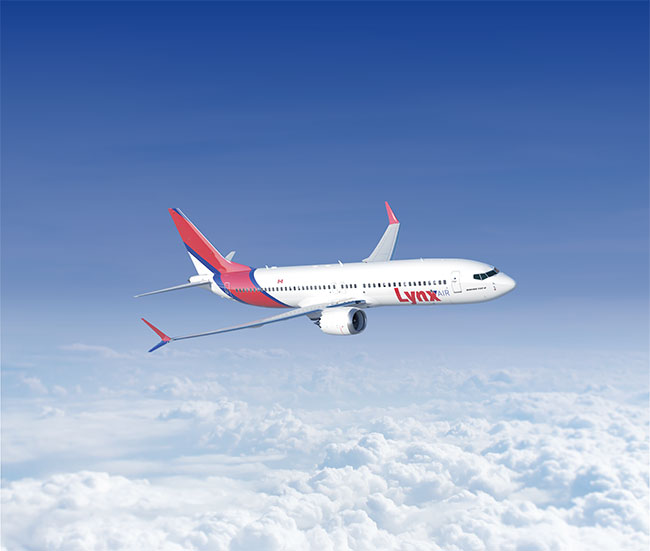
Features
Readjusting the playing field, the demise of Lynx and ULLC barriers
The barriers facing ultra low cost disruptors in Canadian aviation
March 26, 2024 By David Carr
 Canadian cost recovery adds about 35% to the price of a ticket when compared to the U.S. with its infrastructure subsidies.
Image: Lynx air
Canadian cost recovery adds about 35% to the price of a ticket when compared to the U.S. with its infrastructure subsidies.
Image: Lynx air Another air carrier enters the elephant graveyard of failed Canadian airlines. In February, Calgary-based Lynx Air ceased operations, days after merger negotiations with Flair Airlines fell apart. Another promising ultra-low-cost disruptor laid off workers, stranded passengers and disrupted thousands of family vacations, days before March break. Nothing the Trudeau government’s vaunted Airline Passenger Bill of Rights can do for them. Just a disingenuous statement from the transport minister expecting Lynx Air to fully refund its passengers, which is as likely as Ottawa getting back the $60 million it wasted on the ArriveCan app fiasco.
Canada was once an Ultra Low Cost Carrier (ULCC) wasteland. Start-ups struggled to get off the ground. U.S. discount airlines still park their jets just south of the border. Canada is a high-cost country. Better that the market comes to them, which we do, in the millions. The landscape shifted around 2018. Swoop, a discount subsidiary of WestJet, and Flair Airlines launched. Lynx Air and Canada Jetlines would follow, post-COVID. Porter Airlines’ business model slots its fare structure between Air Canada/WestJet and the discounters. Selling a redefined economy cabin where 90 per cent of us sit.
The collapse of Lynx Air has kicked off a new round of questions on whether a ULCC can survive in Canada. The debate is a bit premature. Flair is still flying, although its own financial difficulties, including airplanes seized and owing the Canada Revenue Agency more than $67 million in GST payments on Boeing 737 MAX jets, are well documented.
Canada has relaxed foreign ownership rules to 49 per cent and both Flair and Lynx entered the market with deep-pocket backers with airline experience; Miami-based 777 Partnerships and Phoenix-based Indigo Partners, which are behind several ULCCs, including Frontier Airlines in the U.S. and WizzAir in Europe. Clearly, it’s not enough.
Out of the gate, the ULCC sector, like all airlines operating in Canada start at a cost disadvantage vis-á-vis the United States. Canada’s cost-recovery model can add 35 per cent to the price of a ticket compared with the U.S. where air transport infrastructure is heavily subsidized and the Biden administration just gifted almost US$1 billion in capital funding to improve 114 airports, including some of the nation’s busiest and most successful commercially.
This is where the discussion becomes more philosophical. If only 44 per cent of the population flies, is it really a discounted air fare if the other 56 per cent are chipping in to cover infrastructure costs via taxes? This is why the Canadian model, albeit bloated by taxes, user fees (a 33 per cent hike in airport security this year) and unaccountable airport authorities, presents a more accurate reflection for the real cost of flying.
But these charges don’t tell the whole story and do not fully address why discounters struggle in Canada while soaring elsewhere. It comes down to a regulatory framework that benefits larger airlines and is not working for the upstart ULCC sector in Canada. Foreign ownership rules may have been relaxed to 49 per cent, but single investors such as 777 Partnerships are restricted to 25 per cent ownership, limiting a newcomer’s ability to attract the capital needed to scale up against Air Canada and WestJet. The exodus to border airports in the U.S. each year in search of cheap airline seats suggests Canadians care little about whose flag is on the outside of an airplane and would welcome increased foreign ownership of domestic airlines if it meant stable access to lower fares at home.
It is time to discuss whether, instead of maintaining a level playing field where advantage rests in the hands of established airlines, that this same field is tilted slightly in favour of newer players. It is an idea that is not without precedent. During the 1995 open skies agreement with the U.S., Canadian carriers were given a three-year head start on opening new routes out of Toronto and two years out of Montréal and Vancouver to give the Canadian airline industry a fighting chance against its larger Americans competitors at its busiest hubs.
Likewise, the Canadian Radio-television and Telecommunications Commission recently ordered large telecos like Bell and Rogers to provide temporary open access to their fibre-to-the-home networks in Ontario and Quebec to stimulate competition.
The greatest barrier to market disruptors in Canadian air transport is indifference. Despite being self-described champions of the consumer, Ottawa and its agencies refuse to create conditions that will allow the sector to thrive. Even after the sad departure of Lynx Air, that is not about to change.
David Carr is a former editor of Wings and Helicopters.